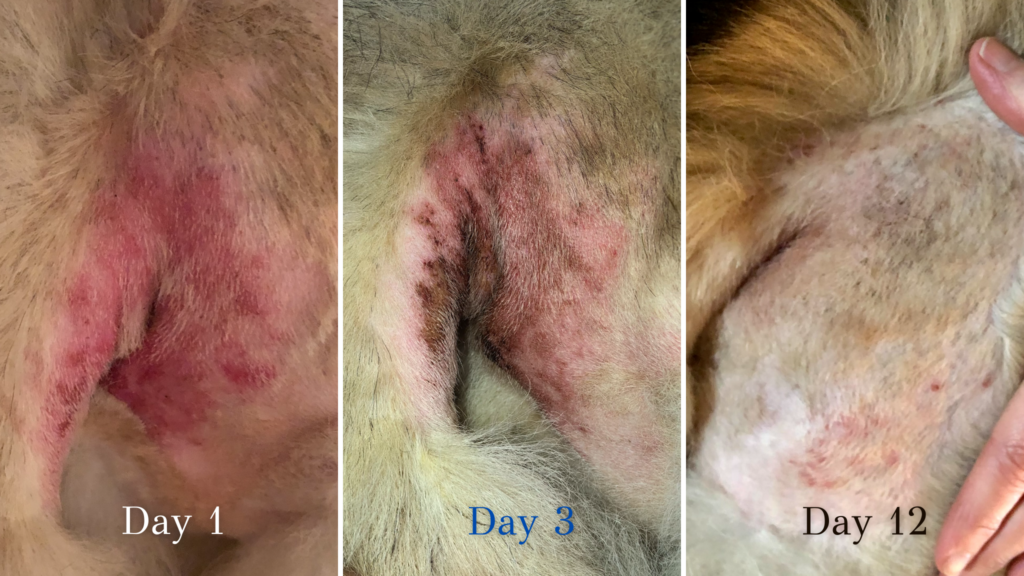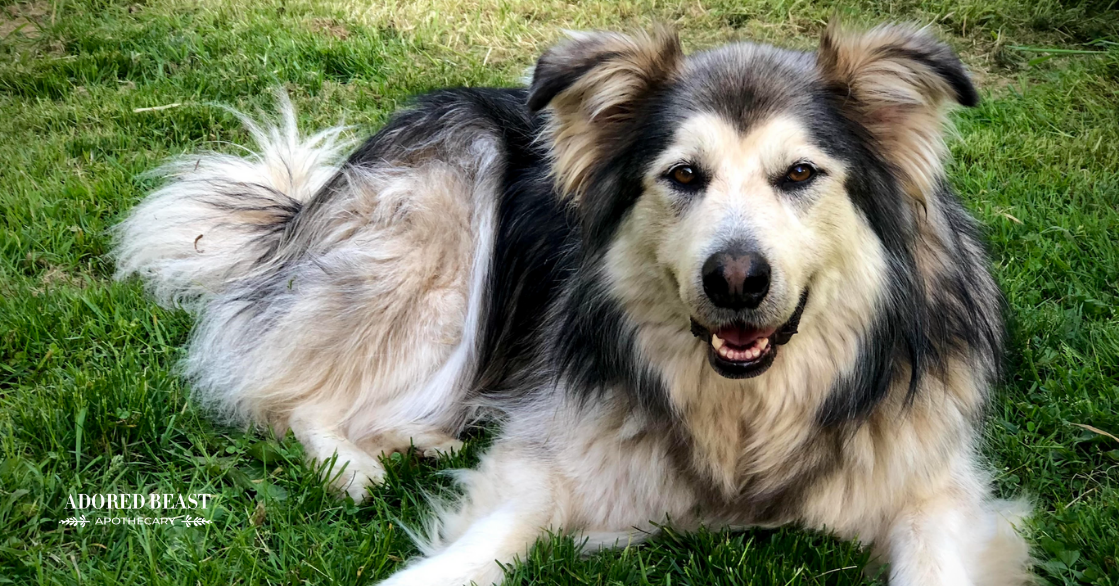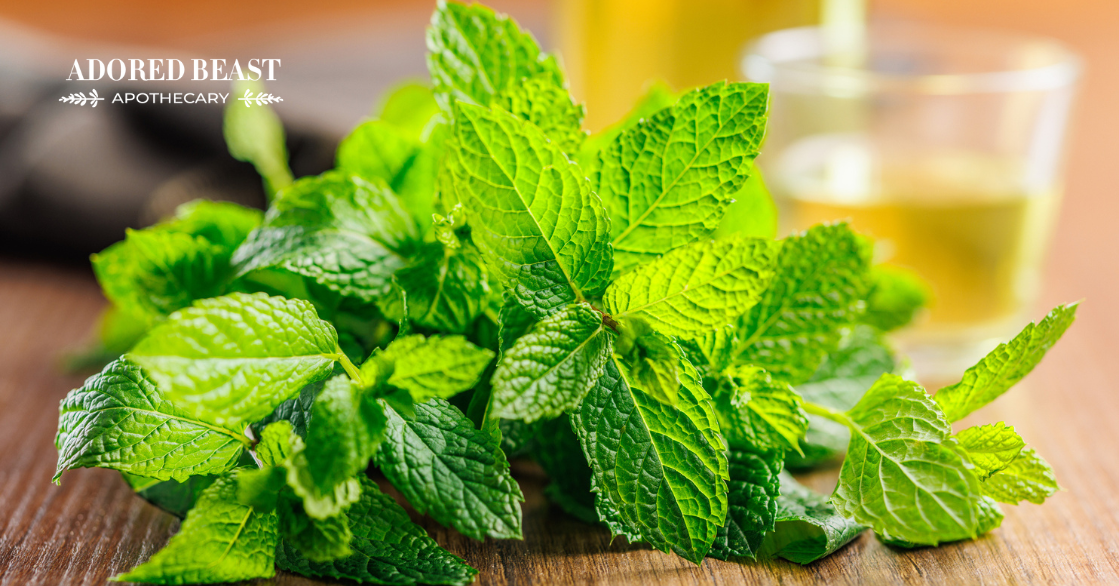Hot spots on dogs are so, so common. Often they start out as a small red area that owners may mistake for an insect bite. Then they grow. And grow. And grow…
I started writing this blog post about hot spots about a month ago. And as luck (or bad luck) would have it, my own dog, Easton, developed a hot spot right as I was starting this. Wasn’t this perfect timing on his part? Who could predict I would be treating him for hot spots while attempting to explain what they are and how to treat them? Thanks to my boy for the inspiration and guidance!
Hot Spots on Dogs: What are They?
Hot spots are an immune-mediated skin response. They’re a common skin disorder that can spring up quickly. They’re also known as acute moist dermatitis, pyotraumatic dermatitis, or pyoderma. The names appropriately describe what is happening on the skin: redness and inflammation, with or without pus, caused by either bacteria or trauma. They’re more common when the weather is hot and a dog’s coat holds more moisture and heat. They can also be more common in dogs with long coats and/or a thick undercoat.
My boy is a husky mix with that classic double coat. And although he does periodically get hot spots, they usually happen the summer. It was odd to see a major nasty one popping up in the middle of winter. It’s very hard to say what might have brought this on, and generally it’s hard to pinpoint a cause. After all, they can start with a bacterial infection, from trauma to the skin like excessive licking or scratching, or they can be the result of food or environmental allergies. Even a flea or parasite issue can cause bites to develop into hot spots.
Hot Spot Symptoms
What do hot spots look like? Red, hot, inflamed skin lesions. They may or may not be wet and leaking pus. They can be itchy and/or painful, and cause a dog to scratch or lick excessively, which creates more damage. Hot spots can spring up anywhere on the body, but you’ll most often find them on the torso, hips, sides of the body, to in the bends of the skin like where the legs or tail meet the body. They can be hidden under matted fur (a breeding ground for moisture and bacteria).
A hot spot can start with a small pinpoint and quickly spread into a giant goopy mess. This is especially true for dogs with long coats where it can go undetected.
When you find a hot spot, always inspect the skin in a very wide area around the hot spot to find other spots potentially forming. Whenever your dog is focussing on or obsessed with a specific area of the body, have a really good look to see if something is brewing. Always inspect for fleas or lice so you can rule out those nasty pests as a cause. A dog might also over-lick an area that is painful due to arthritis, injury, or disease, so it is always a good idea to rule out deeper issues as a causation.
I first noticed Easton trying to lick his bum area, so I lifted his tail but didn’t see anything obvious. As he continued licking and flipping back to try to get something around his butt, I inspected further. I made sure to check his anal glands, but they were not the issue. I eventually uncovered a huge hot spot all around his anal area and under the base of his tail. Upon further inspection, I noticed the area of redness had spread, so I had to cut away a much larger area of fur.
How to Treat Hot Spots on Dogs:
Treating hot spots on dogs can be pretty labour intensive. Conventionally, treatment depends on the cause. It can involve the use of antihistamines or steroids, antibiotics, and usually antibacterial, antiseptic washes on the affected area. I would try to avoid conventional treatments if possible as you can definitely treat hot spots naturally without the side effects of medication.
These are some important general tips to keep in mind, no matter how you treat a hot spot:
- All the fur around the hotspot needs to be cut away or shaved in a wide margin. This is so that the fur doesn’t stick to it and the area can be kept as dry as possible.
- Wash and compress the area to remove debris and pus. This is really important and needs to be done 2-3 times a day for the first few days. (As the hot spot dries out and heals, cleaning can be done less often.)
- When cleaning the hot spot, it’s important to gently clean away any hardening crust or pus that is building up. The hot spot needs to heal from the outside-in and from the bottom-up. Keeping the surface clean is important so bacteria doesn’t build up underneath.
- Once washed, let the area dry out. You want to keep it clean and dry.
- Keep your dog from licking or scratching at the hot spot. An E-collar (cone of shame), a soft or inflatable collar, a t-shirt, socks, etc., are all helpful if your dog is licking the area. This is important when not under supervision like at night or if home alone. You may have to bandage a hot spot if it’s on a leg that the dog has easy access to. Note: this is a double-edged sword because ideally the hot spot should be left open to dry as much as possible. .
At-Home Treatment for Hot Spots
This is how I treat Easton’s hot spots:
- Twice daily cleaning and compressing with warm, clean water with hypericum (St. John’s Wort) tincture (40 drops per ¼ cup water).
- I also use an equal amount of hydrastis (Goldenseal) tincture. Note: this slow-growing herb can be very hard to find now as it is endangered. A good alternative would be Oregon grape root. Another option is organic green and/or chamomile tea, made as a strong brew and cooled to warm.
- You can also add hypericum, hydrastis or Oregon grape root tincture to green or chamomile tea as a wash.
- Once the hot spot is no longer moist and angry looking, I stop hydrastis but continue with hypericum, and added calendula tincture and use that until it heals fully. Calendula is a great skin healer, but don’t use it on an open wound that is moist or forming pus – it can heal the tissue too quickly and create an abscess underneath. Use calendula once the “infection” stage is complete and the tissues need healing.
- Apple Cider 50/50 with water can also be used but may sting on open skin so be careful or use it once the skin is not open.
Homeopathic Remedies
These are the homeopathic remedies I recommend for hot spots on dogs. This is exactly what what I used most recently on Easton:
To start, I use these remedies 3 times daily for 3- 4 days, then twice daily for 3 more days:
- Arnica montana 1M,
- Hypericum perforatum 1M for pain
- Hepar sulphuris calcareum 200C for infection and pain
At this stage, the redness and inflammation has usually calmed, and the hot spot should be dry and no longer painful.
I then use hepar sulphuris calcareum 200C and silicea 30C twice daily for 3 more days, then silicea 30C only, twice daily for about 5 more days.
I mentioned calendula tincture as part of the cleaning and healing process. You can also use calendula officinalis in homeopathic form once the hot spot is calmer and dry, but I find silicea has a similar action on healing the skin in the case of hot spots. If the tissue is taking a much longer time to heal and needs extra help, use calendula 30C in the latter stages, twice daily for 5-7 days.
There are a variety of other homeopathic remedies for hot spots on dogs, depending on how they are presenting. For instance, I would use apis mellifica and histaminum if allergies are thought to be the cause, but this gets into more custom care. The remedies I use in Easton’s case are generally very good for the nature of a hot spot. In his case, it was completely healed with no further treatment needed after 2 weeks.
Supplements
Supplements I recommend for an active hot spot outbreak:
- Liver Tonic to encourage the liver to remove inflammatory cells.
- A potent probiotic like Fido’s Flora. This helps balance gut flora and heal the gut lining, therefore supporting the immune system, which is under stress. Start small and work up slowly to the recommended amount.
- A super antioxidant like Phytosynergy for its powerful anti-inflammatory affects.
This is a picture of Easton and his hot spot in 3 stages: Jan 25th (Day 1) when it first started, Jan 27th (Day 3), and February 5th (Day 12) when it was almost healed.

Prevention and Final Thoughts
Preventing hot spots on dogs depends on what is causing them.
If it’s thick fur that gets matted (or not) then regular brushing to remove debris and getting good air flow to the skin is key. I would not recommend bathing as this can exacerbate the issue. If hot spots are caused by allergies, it’s important to determine what your dog is allergic or sensitive to and then treat and heal those allergies as naturally as possible.
Along with that, I would follow the principles of holistic health, which include not over-vaccinating and avoiding drugs whenever possible.
In cases where hot spots are not healing naturally, different remedies or conventional treatment may be necessary to prevent deeper infection and abscess. If the hot spot is not moving towards healing in a reasonable time frame, reach out to a qualified holistic animal practitioner who can help guide you or see your veterinarian (preferably a holistic one).
With recurrent hot spots, I would be sure to get some diagnostics like bloodwork done to see if there is an underlying, identifiable cause. If self-trauma is causing hot spots, then it is vitally important to find out what is causing your dog to over lick or self-mutilate. Sometimes boredom and stress can be causing that. In this case I recommend more exercise, more interaction, more time outside, in the dirt, in the woods, off leash if possible, and most importantly, more quality time with you, even if that means cuddling on the couch or playing on the floor. It is essential not only for mental health but also immune health for our dogs and for us two-legged beings also 😊












